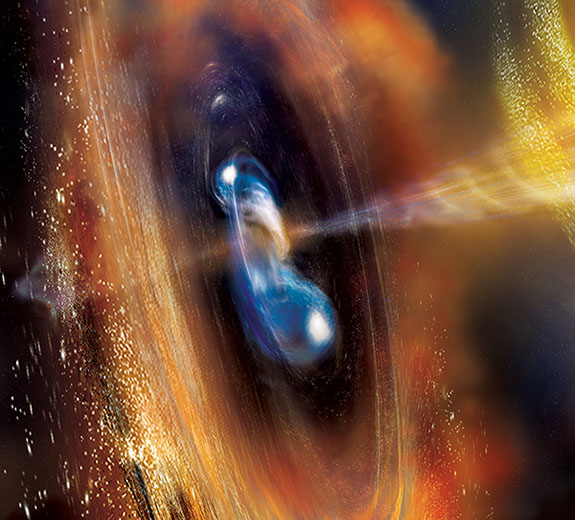Gamma-Ray Burst From Rare Kilonova Signals the Birth of Platinum and Gold
A gamma-ray burst generated by a rare kilonova signaled the birth of platinum, gold and other heavy elements equal to 1,000 times the mass of the Earth, according to an international team of scientists.

On Dec. 11, 2021, NASA’s Neil Gehrels Swift Observatory and Fermi Gamma-ray Space Telescope detected a blast of high-energy light from the outskirts of a galaxy approximately 1 billion light-years away in the constellation Boötes.
This gamma-ray burst, identified as GRB 211211A, lasted about a minute – a relatively lengthy explosion, which would usually signal the collapse of a massive star into a supernova. But during the past year of research, scientists learned that this event contained an excess of infrared light and was much fainter and faster-fading than a classical supernova, hinting that something different was going on.
In papers published in both Nature and Nature Astronomy, an international team of scientists described how the infrared light detected in the burst came from a kilonova, which occurs when two super-dense neutron stars in a binary star system collide, emitting gamma-rays. NASA explained that these are most powerful events in the universe.
When neutron stars collide and merge, they create a cloud of hot debris emitting light across multiple wavelengths. Scientists hypothesize that jets of high-speed particles, launched by the collision, produce the initial gamma-ray flare before they collide with the wreckage. Heat generated by the radioactive decay of elements in the neutron-rich debris likely creates the kilonova’s visible and infrared light. This decay results in the production of heavy elements, such as gold and platinum.
“We found that this one event produced about 1,000 times the mass of the Earth in very heavy elements," noted Dr. Matt Nicholl, an Associate Professor at the University of Birmingham, who modeled the kilonova emission. "This supports the idea that these kilonovae are the main factories of gold in the universe.”
Its proximity in a neighboring galaxy only one billion light years away gave scientists the opportunity to study the properties of the merger in unprecedented detail with multiple telescopes.
Back in 2017, astronomers from around the globe jointly reported a kilonova blast from a clash of neutron stars 130 million light years from Earth in the constellation Hydra. They cooperated in pointing their high-powered equipment at the scene to record the visible light, radio waves, X-rays and gamma rays emitted from the blast.
Their equipment identified massive amounts of platinum, gold and silver, estimated at the time to be worth in excess of $100 octillion. That’s $100,000,000,000,000,000,000,000,000,000 (1 followed by 29 zeroes).
Credit: Graphic by A. Simonnet (Sonoma State Univ.) and NASA’s Goddard Space Flight Center.






